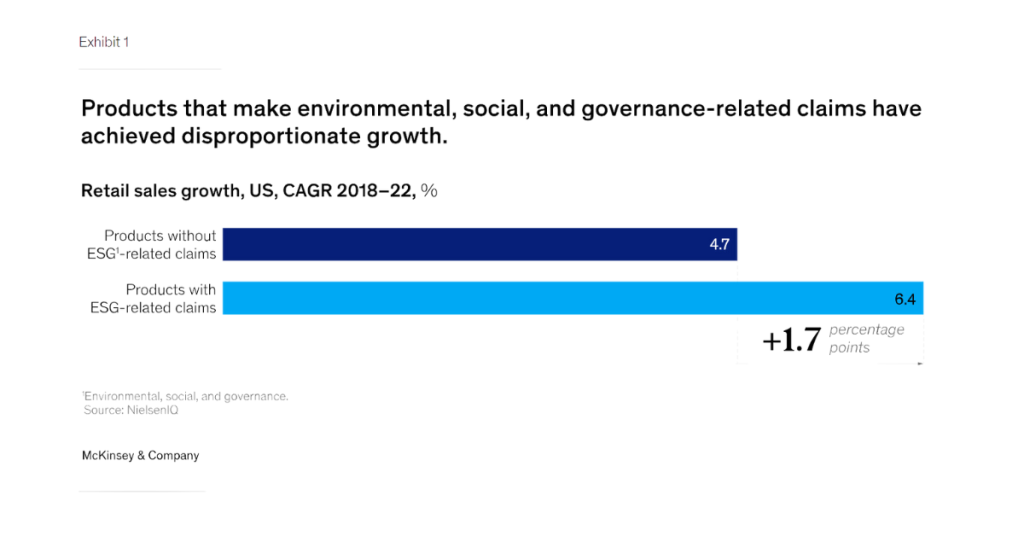Consumer behavior is changing. Driven by climate awareness, Millennials and Gen Z are prioritizing sustainability and urging brands to integrate climate action into their business.
Over the past few decades, consumer trends have been evolving at a rapid pace, with generational shifts playing a pivotal role in shaping the way people live their lives and spend their money. Millennials and Gen Z, the two most prominent generations at the forefront of this transformation, have been witness to extreme weather events, political and cultural movements, and global crises like never before. These experiences have led them to be more conscious about their choices, particularly when it comes to supporting brands that prioritize climate action. This article explores the changing landscape of consumer behavior and argues that brands must put climate action at the center of their businesses to meet the demands of this conscious consumer base.
The Climate Crisis and Rising Awareness
From 1980 to 2022, the United States experienced an average of 8.5 billion-dollar climate disaster events annually. However, in the past five years (2018-2022), this annual average has increased to a staggering 18 such events per year. In 2023, through October alone, there have been 24 billion-dollar climate events in the US. These escalating numbers are not limited to the US, as climate-related crises are becoming more frequent and severe worldwide. This relentless onslaught of climate crises has prompted a growing awareness of climate change and its dire consequences.
In a recent McKinsey and Nielsen IQ survey, an overwhelming 78% of US consumers expressed the importance of embracing a sustainable lifestyle. This data demonstrates that consumers are recognizing the urgent need for a transition towards a more sustainable future. They are increasingly conscious of their spending habits and expect brands to align with their values.
Generational Shifts: Millennials and Gen Z Leading the Way
A significant driving force behind this shift in consumer behavior is the generational change in demographics and values. Millennials and Gen Z together currently represent 43% of the US population and 49% of the global population. As we move forward, these generations are set to inherit trillions of dollars, bringing substantial economic influence into their hands.
These two generations have grown up amidst transformative global events, including the COVID-19 pandemic and an increasing number of natural catastrophes. These experiences have profoundly shaped their worldviews and priorities. Environmental and social concerns now hold a more central place in their lives than in previous generations.
For instance, 75% of Millennials are so eco-conscious that they are willing to change their buying habits to favor environmentally-friendly products. Additionally, 62% of Gen Zers prefer to buy from sustainable brands, and 73% are willing to pay more for sustainable products. These statistics represent the significance of these generations in shaping the future of consumer patterns.

The Call for Climate Action
Brands are facing an imperative to adapt to this changing consumer landscape. The new generation of consumers demands that companies take a stand on climate action and sustainability. They are no longer content with just purchasing products; they want to support brands that reflect their values and contribute positively to society and the environment. To meet these evolving expectations, companies must integrate climate action into their business models. This could involve adopting sustainable practices in their operations, investing in renewable energy sources, reducing carbon footprints or supporting global initiatives to balance out the emissions that can’t be eliminated as a result of your business operations.
The Benefits of a ‘Planet over Profits’ Approach
As climate change becomes a pressing global concern, consumers are actively seeking brands that share their values. By aligning your brand with environmental initiatives, you not only contribute to a greater good but also establish a strong connection with your audience.
The advantages of incorporating climate action into your branding strategy are numerous. Not only can it enhance your brand’s reputation, but it can also develop customer loyalty. Studies show that consumers truly care about sustainability and are willing to pay more for products and services from environmentally responsible companies. Brands that prioritize sustainability and climate action enjoy a competitive edge.

How to Incorporate Climate Action into your Business
Step 1: Define Your Environmental Values
The first step to boosting your brand identity through climate action is to define your environmental values clearly. Ask yourself what aspects of climate action align with your brand and resonate with your target audience. Consider how your products or services can contribute to a greener future.
For inspiration, take a look at brands like Patagonia, which have successfully integrated environmental values into its identity by prioritizing sustainable materials and ethical production. They have also made a clear commitment to encouraging their customers to join the climate action movement.
Another example, our customer, Santander, who has become a sustainability leader within the banking industry for incorporating carbon footprint calculation into their mobile banking app. Empowering their customers by educating them and encouraging them to make planet-positive choices daily. Through the integration of the ClimateTrade Marketplace, customers can also choose to offset or neutralize the emissions from their daily purchases by supporting environmental projects that are protecting and restoring our natural world.
Step 2: Measure Your Impact and Implement Sustainable Practices
Once your environmental values are clear, it’s crucial to take the first step in your climate action journey by measuring your environmental impact using tools like our carbon footprint calculators. This initial measurement is essential in understanding the baseline of your environmental footprint. Once you have a clear picture, it’s time to put your values into action. Implement sustainable practices throughout your business operations, which could involve reducing waste, conserving energy, or sourcing eco-friendly materials. These practices not only reduce your environmental impact but also demonstrate your commitment to the cause.
At ClimateTrade, we firmly believe that climate action should be accessible to everyone. That’s why we work with organizations to help them embed climate action technologies, including our carbon footprint calculators, into their daily business operations. By quantifying your environmental impact with precise tools, you not only support your business in achieving its ESG initiatives but also empower your customers to be an integral part of your sustainability journey.
ClimateTrade’s Marketplace is a dynamic platform where businesses and individuals can seamlessly engage in climate action and sustainability initiatives. It hosts the world’s largest directory of carbon offsetting and environmental protection initiatives, making it easy for organizations to reduce or balance their environmental impact.
Step 3: Sustainability Marketing and Communications
Transparent and authentic communication is key. Ensure that your audience is aware of your climate action initiatives. Use your website, social media, and marketing materials to share your journey towards a greener brand identity. Authentic storytelling and regular updates can engage your audience and build trust.
To inspire your audience to join you on this journey, share stories of how individuals and brands can make a positive impact on the environment. Encourage them to take small steps toward a more sustainable lifestyle and support climate-friendly businesses.
Collaborations with environmental organizations, suppliers, or like-minded brands can be a powerful way to strengthen your brand identity. Partnering with organizations that share your values can help you amplify your impact and reach a broader audience.
Incorporating climate action into your brand identity isn’t just a responsible choice; it’s also a smart business move. When you define your environmental values, implement sustainable practices, and authentically communicate your efforts, you can boost your brand identity while contributing to a healthier planet. There has never been a more important time to harness the power of climate action to make your brand more memorable and meaningful to today’s environmentally conscious consumers.








